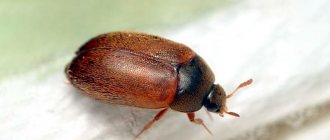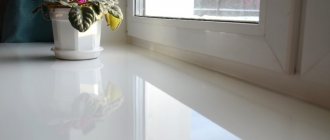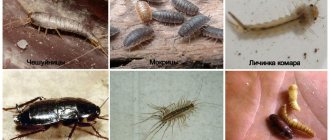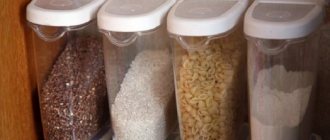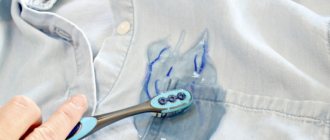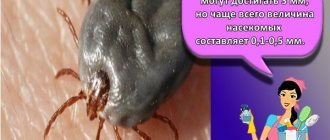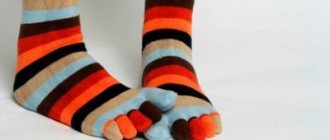Many insects crawl or fly into our homes, but small brown bugs in the apartment are rightfully considered one of the most harmful parasites. Their ability to survive in any conditions is amazing, and this is not surprising, because they can feed on almost any substance, both plant and animal, and dead tissue. In addition, their species composition is diverse, biologists count more than 600 species of leather beetles, this is the common name of their family, and in everyday life they are called the same.
This is what the brown bugs look like in the photo at high magnification.
What kind of bugs are these?
Many people faced with this problem are concerned about one question - what kind of parasites are these?! Small black or brown bugs that live in the apartment are called skin beetles. They enter the room in several ways - through windows, ventilation holes, cracks in the floor and walls, as well as through clothing, shoes and hair. An adult insect has an oval body shape, the length of which does not exceed 5 mm. It practically does not move, and in times of danger it completely freezes. If you touch the skin beetle with your finger, it will roll over onto its back. Most often, residents of apartment buildings become acquainted with them.
To lay eggs, leather beetles choose surfaces with a fleecy or rough texture - wool, carpets, fur, and various fabrics. Breeding time is from April to June. The female lays eggs for 2-10 days. Their largest number is almost a hundred during the period. The eggs are white in color, up to 2 mm long, and very soft and pliable to the touch. The duration of their development ranges from 2 to 60 days - the exact period is affected by air temperature. Having emerged from the cocoon, the newborn bugs almost immediately set off in search of a partner for mating. In one year, a whole generation of insects can appear in an apartment! Interestingly, the female, having completed her mission, immediately dies.
Carpet beetles prefer to live in well-lit places, so they can be seen on the windowsill or in lamp shades. But they are not at all attracted to moisture in toilets and bathrooms.
Where do they come from
In addition to the fact that insects enter through open windows or vents and all sorts of cracks in them, there are several other ways for skin beetles to enter an apartment. Let us briefly outline the paths of saboteurs:
- purchasing new products already infected with bugs;
- on the body of pets after a walk;
- ventilation ducts.
In any case, you need to be careful and careful.
Advice! It is easier to prevent trouble than to fight it!
Classification of domestic skin beetles
There are several types of carpet beetles. Some settle in living rooms or bedrooms, while others move into the kitchen and spoil food supplies. Only the larvae pose a danger to people - they begin to actively feed immediately after birth. But adult beetles eat only plant sap or nothing at all.
- Carpet moths are dark brown individuals that feed on house dust;
- Ham - in the European part of the world this is the most popular type of beetle. Its main distinguishing feature is its body shape - long, with yellow spots on top; Smirnov's carpet beetles - these small bugs, more often than other species, settle in apartments; House or museum bugs - hide in flowerpots; Fur bugs - the most harmful type, eats homemade products, It is distinguished by its black spotted coloring.
The beetles of the fur coat beetle are brighter in color than the beetles of the carpet beetle.
To make it easier for you to recognize these bugs, we provide you with photos and names for them.
Larvae also have their own classification:
- Anthrenus - found on clothing and other fabric surfaces; Attagenus - found in bulk products, on carpets, at the bottom of drawers and bags, under parquet boards.
Interesting! Skin beetle larvae will not tolerate bright lighting - they live in dark places.
Mucoeds
They are polyphagous beetles, that is, their menu is very diverse. Three types can be found in apartments.
Surinamese
A beetle 3-3.5 mm long with a red-brown back. The pest is flat, very elongated in length, with a thin body. The pronotum has characteristic longitudinal “ribs”.
Interesting!
The first copies were delivered from Suriname, hence the name. Distributed everywhere.
Prefers bakeries as a bottomless source of nutrition. But often, along with flour and cereals, it gets into apartments, where it infects other supplies. The vital activity of bugs leads to an increase in humidity in products, which is why mold forms in cereals.
Maximum lifespan 3 years. Usual 6-10 months. The life cycle is 27-51 days at a temperature of 29-35°C.
During her life, the female lays 43-285 eggs. At an ideal temperature of 27-29°C, the larvae hatch after 3-5 days. The larva grows up to 3 mm, has a yellow-white color and a brown head.
On a note!
Theoretically, Surinamese mucoeds fly, they have wings. In practice they just crawl.
Red mukoed
The light brown beetle is approximately 2 times smaller than its Surinamese “brother”. In the apartment, the food supply, habitats and life cycle are similar to those of the Suriname mucoedeater. A distinctive feature of the red mucous eater is inactivity.
Mucoeds
Merchant beetle
A flat small beetle, 2.5 cm long. Almost completely identical to the Surinamese beetle in morphology and lifestyle, differing in eye size and head shape. The bugs crawl actively, moving to new habitats.
Are skin beetles dangerous?
Domestic skin beetles cause great harm. They can ruin the entire supply of dry foods, as they easily penetrate even tightly closed jars of cereals or flour. These bugs live in bread bins and cabinets. Of course, you can try to clean the cereal from insects, but there will still be eggs, so you will have to throw everything away.
Books and stacks of papers also suffer from bugs - leather beetles are considered the most dangerous enemies of archives, museums and libraries. The danger zone includes carpets, natural fabrics, products made from wool, fur, skins, horns, feathers, hair, down and felt - bugs will immediately spoil them. In this case, they act no worse than moths - they cut off the fibers and gnaw through entire holes.
The excrement of these small bugs is also dangerous to human health. Once in the body along with food, they can lead to the development of an allergic reaction. Its main manifestations are coughing, asthma attacks, redness of the skin and the appearance of a small rash.
But there is no need to be afraid of skin beetle bites - despite the “telling” name, human skin is of no interest to them. These insects bite only in certain situations - for example, during a sudden change in environmental conditions, repairs and moving.
The damage caused by these insects
Under certain conditions, carpet beetles and anthrenuses can cause significant harm. These pests chew drywall, wooden furniture, including electrical wiring. These insects can be found in any room of a person’s home.
Tiny insects can infect humans with various types of diseases as they move across various surfaces, sometimes dotted with pathogens. This is the case when talking about sanitation makes no sense at all.
How to remove brown bugs?
How to get rid of brown bugs in an apartment? Act immediately, without waiting for parasites to start spoiling your things! There are several ways to kill these insects. Let's look at each of them.
Method 1. Insecticides for skin beetles
Chemical agents allow you to very quickly destroy all the bugs. You can safely use:
- Anti-moth preparations – “Raid”, “Antimol”, “Raptor”, “Clean House”, “Armol”. With their help, you will destroy the bugs in literally 2 hours. The only drawback is that skin beetles quickly develop immunity to these poisons, and many chemicals have no effect on them at all. If this happens, repeat the treatment after a few days, using an insecticide with a different composition.
- Powders (dusts) kill not only adults, but also larvae. Such products are rubbed into fabrics and furniture upholstery, and also scattered on floor coverings. If desired, the dust can be diluted with water, poured into a container with a spray bottle and poured into hard-to-reach crevices.
- Anti-moth tablets and fumigators – “Nimol”, “Molemor”, “Antimol”, “Dezmol”. The tablets are laid out on the shelves of the cabinets, and the fumigators are plugged into sockets - one for each room. When using this method, be very careful - by impregnating clothes, tablets and fumigators with their smell, they can cause unpleasant consequences and allergies.
- Aerosols – “Difox”, “Raid”, “Molemor”, “Clean House”, “Dichlorvos”, “Raptor”. To remove skin beetles from clothing and fur products, treat the item with an aerosol, then place it in a plastic bag for 4-5 hours. It is during this period that all flying bugs will die. Upon completion of processing, remove the product to fresh air for long-term ventilation. Aerosols are also suitable for disinfestation of the entire apartment. It should be applied at a distance of about 20 cm from the surface. Usually one procedure is enough to completely destroy insects. If, after some time, new individuals appear in the room, it means that the eggs have survived, and therefore the treatment must be repeated.
- Microcapsule concentrates for sprays - “Difos”, “Foxid”, “Executioner”, “Mittoks”, “Get”, “Morimol”, “Supronit”. Each spray contains an insecticide that has a contact effect. Getting on the chitinous shell, the poison causes paralysis and leads to the rapid death of the skin beetle. The listed preparations provide reliable protection for the premises for a whole year and do not require re-treatment - newly hatched larvae of brown beetles will die immediately.
- Boric acid - the powder of this powerful insecticide should be scattered around the entire perimeter of carpets, as well as on the windowsill and under the baseboards. This product is completely safe for humans, but if you have small children or pets, be very careful. There are cases where boric acid led to food poisoning and allergies.
The most effective are drugs based on allethrin, chlorpyrifos and bendiocarb. These chemicals are ideal for disinfecting carpets as they do not leave behind stains. Before applying the insecticide, the surface must be thoroughly vacuumed. During the pest control process, be sure to treat the walls and backs of furniture. This should be done at a height of 1.5 m from the floor - applying the product higher is useless - bugs do not live there.
When using insecticidal preparations, do not forget to be careful. The presence of protective equipment (rubber gloves, masks, clothes with long legs and sleeves) is a must! At the end of the process, the room should be well ventilated and wet cleaned. Rinse especially thoroughly those areas that come into contact with your hands. Everything else can be left untouched for now in order to extend the time of the insecticidal effect.
Advice! If you use a chemical insecticide in the kitchen, be sure to store the food in the refrigerator or sealed bags.
Method 2. Freezing
Another common and quite effective method for removing brown bugs. If they are in your home, cool the room to -11 degrees. Maintain this mode for at least 3 hours. Carpet beetles are heat-loving insects, so they are unlikely to survive severe frosts. Small items that brown bugs might like should be taken out into the cold or placed in the freezer for about 3 hours.
Unfortunately, this method has several disadvantages. Firstly, flying bugs can reliably hide in some secluded and warm place, keep warm and stay alive. Secondly, freezing will have to be repeated several times, otherwise the effect will not be achieved. Thirdly, it is necessary to carefully prepare the room before the start of the procedure - cover household appliances, remove indoor plants and insulate the heating system. Otherwise, you will face considerable damage.
Method 3. Folk remedies
Natural recipes give good results, but are most often used for preventive purposes:
- Place cotton pads soaked in essential oil of lavender, lemon balm or tansy in your apartment;
- Dilute 1 tbsp. l. vinegar in 1 liter of hot water, pour the liquid into a container with a spray bottle and spray cabinets, window sills, shelves and baseboards; Permethrin pyrethroid. Buy the product at the pharmacy, dilute it in water and use it to soak fur and wool items that have bugs in them.
Fragrant products only repel skin beetles, but do not kill them.
Method 4. Physical destruction
General cleaning will help you get rid of brown bugs in the early stages. If you start it on time, insecticide treatment may not be necessary.
- Inspect everything that is in your home; Take a good vacuum cleaner over all surfaces - this will get rid of not only adult insects, but also larvae. Be especially careful in areas where there is a lot of debris and dust. After cleaning, shake out the contents of the bag outside and wash in hot water;
- Wash all surfaces from baseboards to flowerpots with water with the addition of soap base, vinegar or ammonia; Put everything that can be washed in the washing machine set to the highest temperature, and then iron it with a hot iron. Pay special attention to seams and folds.
Washing in hot water and then ironing the clothes will help get rid of skin beetle larvae and eggs.
Advice! For preventive purposes, wash the floors with a vinegar solution for another 3-4 days.
Appearance Features
The order of arachnids received its name because of its unusual pedipalps, which end in claws, like those of a scorpion or crayfish. In total, 3,300 species of pseudoscorpions are known. They live in tropical countries and continents with cold climates. They live in caves, high in the mountains, and holes in the ground. There is only one species found in a person’s home – Chelifer cancroides. Found in books and dusty rooms.
- The book false scorpion looks like a house tick. The body is flattened, miniature, with a dense chitinous cover. The adult size is 3 mm.
- In front is a small cephalothorax with two claws - modified pedipalps. The beetle, similar to a crayfish, uses its “weapon” to capture prey, grind it, and crush the integument. The length of the claws is equal to half the small body of the beetle.
- Colors in brown tones - dark, light. Sometimes the beetle is perceived as black. The abdomen has even stripes.
- 4 pairs of legs are attached to the cephalothorax. Short but strong. They end in claws. The pseudoscorpion moves slowly, often sideways, but can walk forward and backward.
A photo of an insect similar to a scorpion is located below. Females are slightly larger than males. The larvae are initially born white, then the chitinous cover darkens, and after the first molt it becomes denser.
How to eliminate skin beetles in the kitchen?
What to do if small brown bugs appear in the kitchen? The same methods apply to them as to moth larvae:
- Wipe down all cabinets containing food supplies with a damp cloth. Add a little ammonia or vinegar to the water; Check flour, nuts, cereals and dried fruits. Anything that is heavily contaminated should be thrown away. The rest can be processed by heating in the oven or placing in the freezer for three to four hours. Then the cereals are washed well and dried. Of course, this won’t work with flour - you’ll have to get rid of it anyway; Place any remaining supplies in airtight containers.
The process of fighting brown bugs is complicated by the fact that these insects lead a predominantly hidden way of life. Young individuals are more sensitive to poisons, so do not delay the start of the fight. The most productive period is considered to be from May to October.
Signs of defeat
Wood-boring beetles reproduce very quickly. These pests begin to destroy wood at an early age
Therefore, it is very important to promptly notice signs of their presence on the site.
Presence of holes on wooden surfaces. The beetles that live in the house always make small holes or full-fledged passages in the tree. Wood flour often pours out of them. Small larvae can also hide in these passages.
Light weight of building materials
When buying boards for finishing a house or bath, you should pay attention to their weight. If the tree seems too light, this may also be a sign of woodworm damage.
They usually eat the board from the inside.
Unpleasant sound. If there is a beetle in the house, you can recognize it by its characteristic grinding sound. It is heard especially well at night.
Presence of dark spots on the surface. In some cases, brown liquid may ooze from the holes made by woodworms. It has a pungent odor and spoils the appearance of the furniture.
In the evening, these pests can be seen with the naked eye. The easiest time to spot them is during mating season. That's when they leave their shelters. Pests crawl on countertops, window sills, and also fly near lamps. Having noticed such bugs, you need to immediately begin pest control.
Prevention of skin beetles
To never again encounter the appearance of small brown bugs in your apartment, do not forget about prevention:
- In the summer, protect the windows with fine mesh nets; Place the same nets for ventilation; Cover all cracks or crevices with polyurethane foam or plaster; Make cosmetic repairs Before sending seasonal items for storage, spray them with a light solution of permethrin. When you want to wear it again, wash it first;
- Periodically arrange sudden temperature fluctuations; Spray fur coats and hats with an aerosol and place them in bags before storing; Ventilate the room at any time of the year; Inspect clothes and interior items from time to time; Keep the house clean.
See also: How to properly store cereals to prevent bugs?
Source
Risk factors
Skin beetles spread most in those rooms where there are so-called risk zones or where there are objects that are particularly attractive to insects. You need to monitor the appearance of bugs especially carefully if your home has:
- pets whose fur beetles love to eat;
- the same applies to stuffed animals;
- fur coats, sheepskin coats, leather jackets in your wardrobe are a very attractive place for leather beetles;
- The pride of your home - a large library - is also at risk.
Where to look for pests?
Little bugs love warmth and dry air. In the summer, conditions are equally favorable for them everywhere, and in the winter they move into the apartment closer to the heating devices. Eggs are laid in cabinet drawers and on mezzanine shelves. At the same time, adult skin beetles fly freely and are very active in the daytime or when the lights are on.
Carpet beetles are uncomfortable only in damp rooms, so the bathroom can be excluded from the list of treated areas.
Larvae often live in soft and loose materials, so they should be looked for in the upholstery of sofas and armchairs, in wardrobes and linen closets, under carpets and in secluded corners of the apartment. Unlike their “parents,” caterpillars inhabit the darkest and most inaccessible places in the house. They are extremely tenacious and can go without food for months, nestling in a dry and soft cushion of dust.
Danger to people
Carpet beetles not only spoil the food in the house, but also bite the people living there. Their bites are quite painful and dangerous for humans. Redness may appear at the damaged area, turning into inflammation. Pathogenic bacteria can penetrate the wound, causing it to fester . The danger of a bite also consists of the following:
- the appearance of allergic reactions in people prone to them;
- infection with helminths and pathogenic bacteria.
Doctors recommend treating the affected area with a disinfectant to prevent the inflammatory process. It is especially unpleasant when bugs breed in the bed in feather pillows or feather beds. In this case, the danger of a bite increases many times over.
